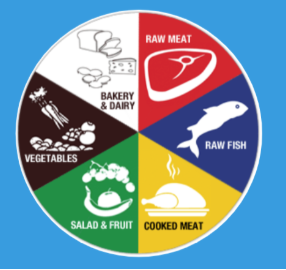Purple chopping board
An addition to the above colours introduced recently by some manufacturers is purple. What is a purple chopping board for? The PURPLE board is used for ‘free-from’ foods such as gluten-free bread or flour mixes.
Purple boards are useful to help cater for people with conditions such as Celiacs. It’s estimated that around 1 in 100 people in the UK are allergic to gluten. So gluten-free diets are becoming more common.
For people trying to avoid gluten it’s important for a catering business to be able to accomodate them. Plastic purple chopping boards can help reduce the risk of gluten contamination in your kitchen or cafe.
More information is in our food hygiene level 1 or 2 course. The course covers which colour coded chopping board to use, personal hygiene, cross contamination and other ways of minimising the risk of illness from prepared food.
So, now lets take a look at some specific questions that get asked and using the diagram decide what colour chopping board should be used. The top questions asked are:
What colour chopping board for RAW MEAT?
- RAW MEAT is prepared on a RED board.
- Raw chicken would be prepared on a red board.
What colour chopping board for FISH?
- RAW FISH is prepared on a BLUE board.
What colour chopping board for COOKED MEAT?
- COOKED MEAT is prepared on a YELLOW board.
- Roast or boiled chicken is a cooked meat, as is fried or boiled fish
What colour chopping board for BREAD, CHEESE and EGGS?
- BAKERY and DAIRY products are prepared on a WHITE board.
What colour chopping board for NUTS, FRUIT, SALAD and green VEG?
- A GREEN chopping board is used for FRUIT, SALAD, GREEN VEG and NUTS
- TIP green = anything fresh and fruity
What colour chopping board for POTATOES, CARROTS or PARSNIPS?
- A BROWN chopping board is used for all ROOT vegetables.
- TIP brown = any earthy foods
Now lets try and answer some more questions that are not as easy to pick out.
What colour chopping board for TOFU?
- TOFU is made from curdled soya bean milk, so it is very similar to cheese. Although it is a vegetable based product, it is not fresh and fruity = green, neither is it an earthy food = brown, but it is similar to cheese and should be prepared on WHITE board.
What colour chopping board for smoked salmon?
- This is not a straight forward answer. Hot smoked salmon is typically smoked at 120-180F, allowing it to cook all the way through. Cold smoked salmon is cured in salt for up to 24 hours before being smoked at 75-85F – this is considered raw.
- So, hot smoked salmon would be prepared on a cooked meat board = YELLOW chopping board.
- Cold smoked salmon is considered raw fish = BLUE chopping board.
What colour chopping board for onions?
- Another question that is not as easy as first sight. An onion is not an earthy vegetable but would it be described as green, fresh and fruity?
- In most kitchens, onions and garlic are prepared on the GREEN chopping board to prevent root vegetable soil getting into the chopped onions or garlic. Usually the board is thoroughly rinsed afterwards to prevent onion and garlic flavours getting into the next prepared product that may be a fresh fruit salad!
More benefits of using a colour coded food preparation system.
As well as helping to prevent a food poisoning outbreak, using colour coded chopping boards can help cater for particular allergies. By keeping different food types on different chopping boards, it is less likely to end up serving chicken with traces of shellfish to a customer who has a shellfish allergy.
UK hospital admissions due to anaphylaxis has increased by a whopping 615% over the last 20 years. So it is essential to take every possible precaution to prevent cross contamination of food and allergic reactions.
Using a universal colour code for the different foods makes it easy to distinguish the intended use for the board at a glance and for professional chefs to walk into a new kitchen and immediately know what’s what.
The code can also be extended to other kitchen items like colour-coded knives and cleaning equipment, and although it’s not the law to have colour coded kitchenware, it’s a system that every commercial kitchen and home cook should adopt to ensure food hygiene standards are the best they can be.










